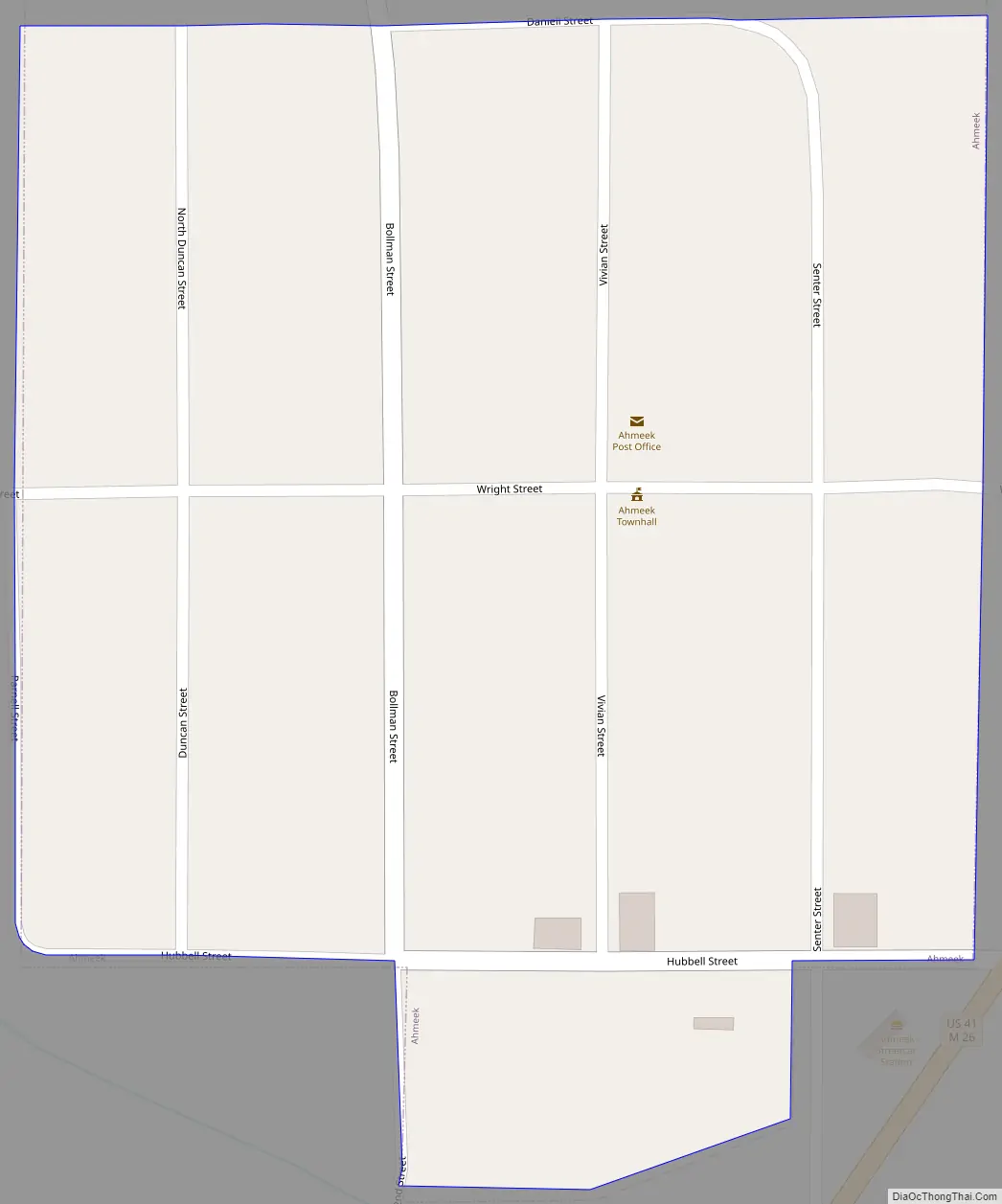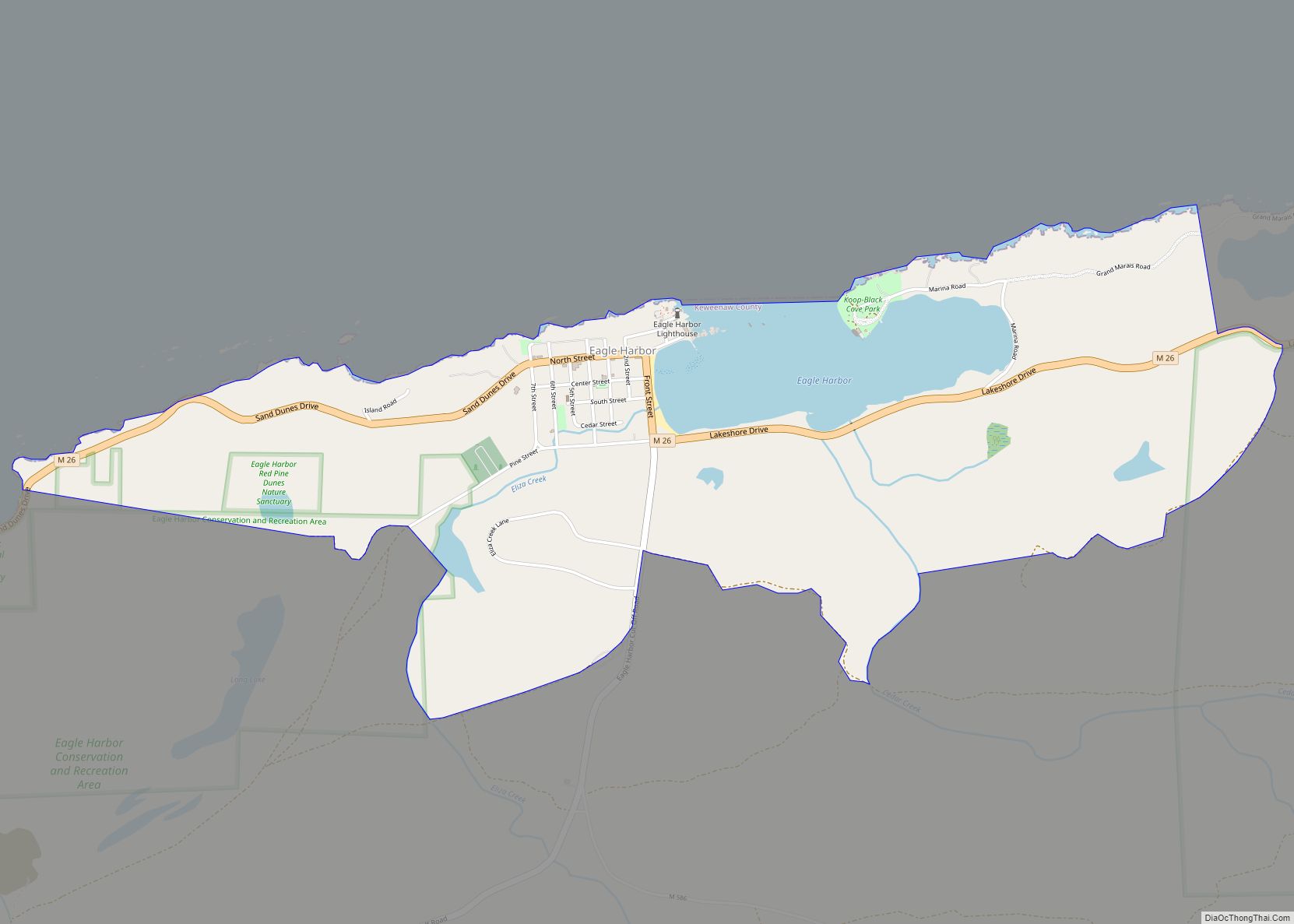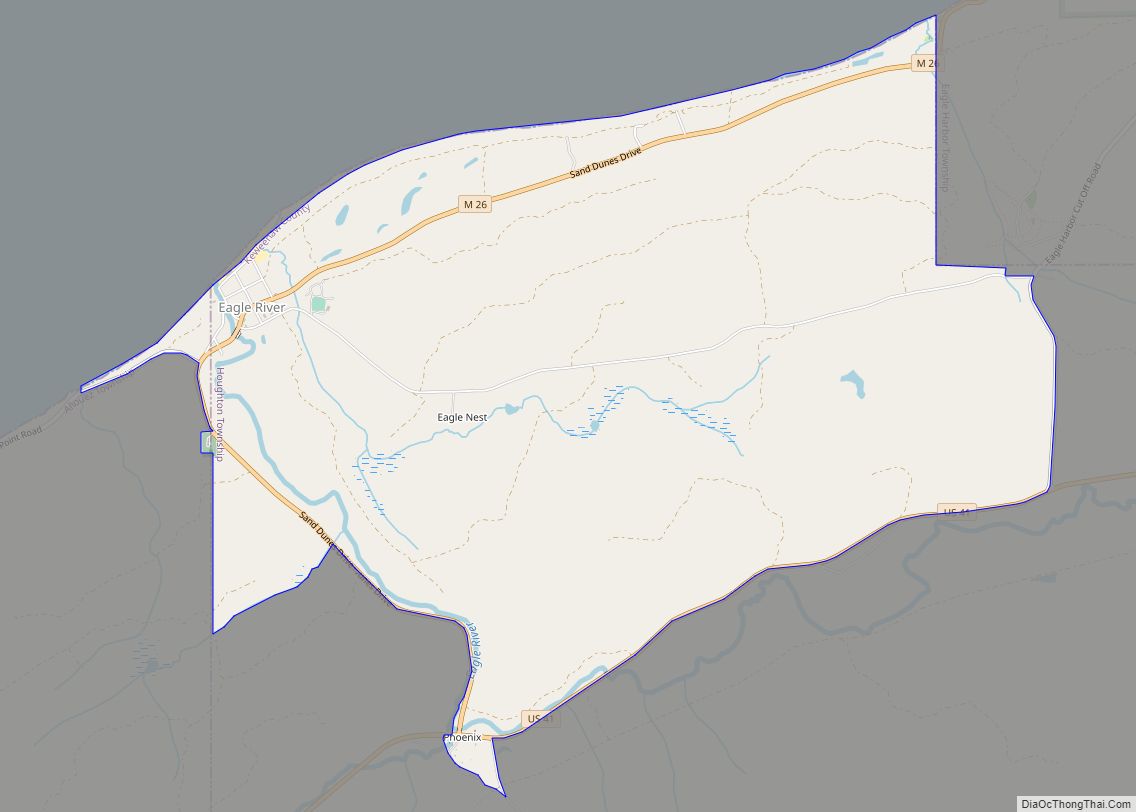Ahmeek is a village in Keweenaw County in the U.S. state of Michigan. The village is located within Allouez Township. The population was 127 at the 2020 census.
At 0.07 square miles (0.18 km), it is the smallest municipality by land area in the state and is the only incorporated municipality in Keweenaw County.
| Name: | Ahmeek village |
|---|---|
| LSAD Code: | 47 |
| LSAD Description: | village (suffix) |
| State: | Michigan |
| County: | Keweenaw County |
| Incorporated: | 1904 |
| Elevation: | 869 ft (265 m) |
| Total Area: | 0.07 sq mi (0.18 km²) |
| Land Area: | 0.07 sq mi (0.18 km²) |
| Water Area: | 0.00 sq mi (0.00 km²) |
| Total Population: | 127 |
| Population Density: | 1,867.65/sq mi (719.36/km²) |
| Area code: | 906 |
| FIPS code: | 2600620 |
| GNISfeature ID: | 2397918 |
Online Interactive Map
Click on ![]() to view map in "full screen" mode.
to view map in "full screen" mode.
Ahmeek location map. Where is Ahmeek village?
History
The name Ahmeek is derived from the Ojibwe (Chippewa) language. The village takes its name from the Ojibwe word, amik, which means “Beaver”, and it was named so because of an abundance of beavers in the vicinity of the present-day village.
The Ahmeek Mine was the most successful mine along the Kearsarge Amygdaloid Lode, which spans through Houghton and Keweenaw Counties, as well as the most profitable, and the largest producer along the lode. The Ahmeek Mine’s Shafts No. 3 & 4 were also one of the most distinctive in all of the Copper Country.
Early days and founding
Mining itself in the community began around the year 1880 as the Ahmeek Mining Company began as an exploratory branch of the already-existing Seneca Mining Company to work the copper-rich Kearsarge Amygdaloid Lode. The Ahmeek Mining Company formally opened in 1903, thus becoming its own separate entity apart from the Seneca, however operations of the Ahmeek Mine under the newly independent company initially began in the year 1902. The local area grew because of its location on the Mineral Range Railroad. In 1908, the construction of the Ahmeek Mining Company Office was completed, as designed by the architect Paul Macneil. The Village of Ahmeek was founded by Joseph Bosch, the creator of the Bosch Brewing Company, in 1904. Attorney James A. Hamilton became the first postmaster of Ahmeek on 5 February 1909, the same year in which it was incorporated as a village. The village was plotted by two real estate agents from Calumet by the names of Faucett and Gunk. The two agents divided the property into lots and then sold them piece by piece. As of the year of the village’s incorporation, Maurice Kenel served as the first village President of Ahmeek, having been elected 15 March 1909. The village firehall was built several years later in 1911 at a total sum of $2,925 dollars. The local Calvary Cemetery, which is also known as the Ahmeek Cemetery, was created a year later in 1912.
Industrialization
Ahmeek served as a critical stop for several transportation services, mostly around the early 20th century. It served as a depot on the Mineral Range Railroad and the Copper Range Railroad and also had a streetcar station for the Houghton County Traction Company, which ran south from Houghton up to Ahmeek, and on north towards Mohawk. The Streetcar Station was completed in the year 1909 and operated under the Houghton County Traction Company until the year 1932, when it served other purposes, such as a bus stop.
Copper Country Strike of 1913–1914
During the watershed moment that was the great Copper Country Strike of 1913–14, Ahmeek was the scene of regular tension and division in the Keweenaw, a key instance being on or about 6 October 1913 when Guy Wilkins, a clerk at the Ahmeek Mine supply office, was assaulted and shot after being confronted by a rogue mob. The strike was the culmination of extensive labour unrest in the area, fueled in large part by unethical treatment by mining companies. The strike brought the once-tranquil and calm Copper Country to violence, from which it would ultimately not recover. Ahmeek, in particular, saw striking miners fire upon a trainload of hired professional strikebreakers engaged by the mining companies, as well as the detonation of an Ahmeek Mine smokestack. Despite local officials’ complaints about the lack of law and order, Judge Patrick Henry O’Brien, who presided over cases related to the violence, ruled that while the strikers were, indeed, in violation of the law, the mining companies themselves had hardly done anything to lessen the tension and had, instead, acted in ways only increasing “the bitterness and hostility” of the situation.
Later years
The Ahmeek Mining Company continued to work the Kearsarge lode through the Ahmeek Mine until the year 1923, when the mining company was incorporated into the Calumet and Hecla Mining Company. Operations of the site under the Calumet and Hecla Mining Company ceased in 1931 under effects of the Great Depression. After the Depression had concluded, the Ahmeek Mine reopened in the year 1936 and carried on until around 1966 when the mine closed permanently. On 30 April 1971, Gabriel J. Chopp, retired after thirty-nine years serving as Ahmeek’s postmaster, thus making him the longest-serving postmaster of the village of Ahmeek, the only incorporated settlement in Keweenaw County.
Ahmeek Road Map
Ahmeek city Satellite Map
Geography
According to the U.S. Census Bureau, the village has a total area of 0.068 square miles (0.176 km), or 42.52 acres, all land.
Attractions
- The Gabriel J. Chopp Park, which is located within the village.
- The historic Houghton County Traction Company streetcar station in Ahmeek, a federally-recognised historic site where you can now spend the night.
- The Ahmeek Ice Rink and its adjacent playground on School Street.
- The Keweenaw Handicraft Shop, a regional home goods store.
- The ruins and leftover buildings of the Ahmeek Mine, including the Mine Office, the No. 2 Shaft of the Ahmeek Mine, as well as the Boiler house, dry house, Hoist house, and shaft of the Ahmeek Mine’s No. 3 & 4 workings may be explored.
- The Lower Falls of the Gratiot River is an area tourist attraction about 3.5 miles southwest of Ahmeek.
- The Sand Hills Light, the last staffed lighthouse on the Great Lakes.
See also
Map of Michigan State and its subdivision:- Alcona
- Alger
- Allegan
- Alpena
- Antrim
- Arenac
- Baraga
- Barry
- Bay
- Benzie
- Berrien
- Branch
- Calhoun
- Cass
- Charlevoix
- Cheboygan
- Chippewa
- Clare
- Clinton
- Crawford
- Delta
- Dickinson
- Eaton
- Emmet
- Genesee
- Gladwin
- Gogebic
- Grand Traverse
- Gratiot
- Hillsdale
- Houghton
- Huron
- Ingham
- Ionia
- Iosco
- Iron
- Isabella
- Jackson
- Kalamazoo
- Kalkaska
- Kent
- Keweenaw
- Lake
- Lake Hurron
- Lake Michigan
- Lake St. Clair
- Lake Superior
- Lapeer
- Leelanau
- Lenawee
- Livingston
- Luce
- Mackinac
- Macomb
- Manistee
- Marquette
- Mason
- Mecosta
- Menominee
- Midland
- Missaukee
- Monroe
- Montcalm
- Montmorency
- Muskegon
- Newaygo
- Oakland
- Oceana
- Ogemaw
- Ontonagon
- Osceola
- Oscoda
- Otsego
- Ottawa
- Presque Isle
- Roscommon
- Saginaw
- Saint Clair
- Saint Joseph
- Sanilac
- Schoolcraft
- Shiawassee
- Tuscola
- Van Buren
- Washtenaw
- Wayne
- Wexford
- Alabama
- Alaska
- Arizona
- Arkansas
- California
- Colorado
- Connecticut
- Delaware
- District of Columbia
- Florida
- Georgia
- Hawaii
- Idaho
- Illinois
- Indiana
- Iowa
- Kansas
- Kentucky
- Louisiana
- Maine
- Maryland
- Massachusetts
- Michigan
- Minnesota
- Mississippi
- Missouri
- Montana
- Nebraska
- Nevada
- New Hampshire
- New Jersey
- New Mexico
- New York
- North Carolina
- North Dakota
- Ohio
- Oklahoma
- Oregon
- Pennsylvania
- Rhode Island
- South Carolina
- South Dakota
- Tennessee
- Texas
- Utah
- Vermont
- Virginia
- Washington
- West Virginia
- Wisconsin
- Wyoming








